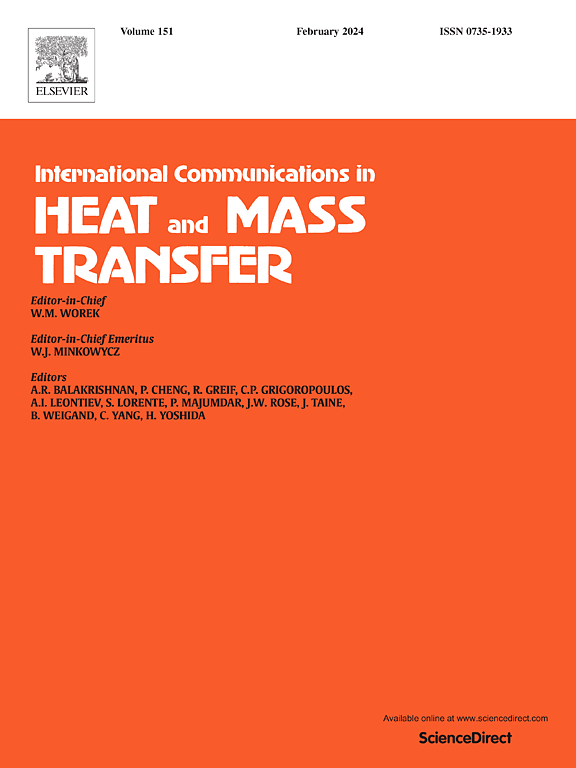A molecular dynamics-informed heat partition ratio model for thermal analysis with frictional contact heat
IF 6.4
2区 工程技术
Q1 MECHANICS
International Communications in Heat and Mass Transfer
Pub Date : 2025-05-09
DOI:10.1016/j.icheatmasstransfer.2025.109052
引用次数: 0
Abstract
This paper presents a methodology for obtaining a Molecular Dynamics (MD)-informed heat partition ratio (HPR) to achieve accurate thermal analysis in the finite element method (FEM). The absorbing energy change in a thermal reservoir of each substrate was determined through MD simulations to calculate the amount of heat flux entering each material. Based on this approach, the HPR model was developed and applied to a continuum FEM model. The validity of the proposed HPR model was confirmed by comparing FEM results with experimental data. The comparison demonstrated that the proposed HPR model provided improved predictions of thermal distribution in brake systems. In particular, the disk, which has high thermal conductivity and does not continuously receive heat, showed temperature results similar to those of traditional HPR models. However, the pad was significantly affected by the HPR model, leading to a more accurate prediction of peak temperature and heat transfer timing compared to traditional HPR models. Specifically, the peak temperature of the pad was predicted with an error of 5.8 % in Type A and 0.5 % in Type B compared to experimental results. These findings suggest that the proposed methodology can enhance the accuracy of thermal analysis in various friction systems.
基于分子动力学的摩擦接触热热分析热分配比模型
本文提出了一种基于分子动力学(MD)的热分配比(HPR)的计算方法,以实现精确的有限元热分析。通过MD模拟确定了各基体在热储中的吸收能量变化,计算了进入各基体的热流通量。基于该方法,建立了HPR模型,并将其应用于连续体有限元模型。通过与实验数据的比较,验证了该模型的有效性。对比表明,所提出的HPR模型能更好地预测制动系统的热分布。特别地,由于圆盘具有高导热性且不连续接受热量,其温度结果与传统HPR模型相似。然而,与传统的HPR模型相比,HPR模型对垫层的峰值温度和换热时间的预测更为准确。具体而言,与实验结果相比,A型预测垫的峰值温度误差为5.8%,B型预测垫的峰值温度误差为0.5%。这些发现表明,所提出的方法可以提高各种摩擦系统热分析的准确性。
本文章由计算机程序翻译,如有差异,请以英文原文为准。
求助全文
约1分钟内获得全文
求助全文
来源期刊
CiteScore
11.00
自引率
10.00%
发文量
648
审稿时长
32 days
期刊介绍:
International Communications in Heat and Mass Transfer serves as a world forum for the rapid dissemination of new ideas, new measurement techniques, preliminary findings of ongoing investigations, discussions, and criticisms in the field of heat and mass transfer. Two types of manuscript will be considered for publication: communications (short reports of new work or discussions of work which has already been published) and summaries (abstracts of reports, theses or manuscripts which are too long for publication in full). Together with its companion publication, International Journal of Heat and Mass Transfer, with which it shares the same Board of Editors, this journal is read by research workers and engineers throughout the world.

 求助内容:
求助内容: 应助结果提醒方式:
应助结果提醒方式:


